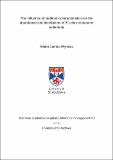Files in this item
The influence of sediment characteristics on the abundance and distribution of E.coli in estuarine sediments
Item metadata
| dc.contributor.advisor | Paterson, D. M. (David M.) | |
| dc.contributor.advisor | Defew, Emma | |
| dc.contributor.advisor | Avery, Lisa | |
| dc.contributor.advisor | Stutter, Marc | |
| dc.contributor.author | Wyness, Adam James | |
| dc.coverage.spatial | x, 277 p. | en_US |
| dc.date.accessioned | 2017-01-23T14:41:00Z | |
| dc.date.available | 2017-01-23T14:41:00Z | |
| dc.date.issued | 2017-06 | |
| dc.identifier.uri | https://hdl.handle.net/10023/10158 | |
| dc.description.abstract | Microbiological water quality monitoring of bathing waters does not account for faecal bacteria in sediments. Intertidal deposits are a significant reservoir of faecal bacteria and this indicates there is a risk to human health through direct contact with the sediment, or through the resuspension of bacteria to the water column. This project investigated factors influencing the relative abundance of faecal indicator organisms (FIOs) in intertidal estuarine sediments. The effects of physical, biogeochemical and biological sediment characteristics, environmental variables and native microbial communities were explored through field campaigns on the Ythan and Eden estuaries, Scotland. The contributory role of sediments to adverse water quality was investigated by combining FIO abundance and measurements of sediment stability. The importance of strain and sediment characteristics in the adhesion of E. coli to suspended sediments was also examined using laboratory experiments. E. coli concentrations up to 5.9 log₁₀ CFU 100 g dry wt⁻¹ were observed, confirming that intertidal sediments are an important reservoir of faecal bacteria. The variability of E. coli abundance in estuarine sediments was successfully explained with multiple stepwise linear regression (Adjusted R² up to 87.4) using easily-obtainable measurements of sediment characteristics and environmental variables, with variability most heavily influenced by salinity and particle size gradients. Native microbial community population metrics and community constituent composition correlated with environmental gradients, but did not influence FIO abundance. The amount of E. coli adhering to suspended sediments ranged from 0.02 to 0.74 log₁₀ CFU ml⁻¹, and was dependant on strain characteristics and sediment type rather than zeta potential, with higher cell-particle adhesion at 2 and 3.5 PSU than 0 and 5 PSU. Monitoring of sediment characteristics will lead to more informed bathing water quality advisories to protect public health. Future research should focus on applying the findings here to the modelling of bacterial fate and transport on a catchment scale. | en_US |
| dc.language.iso | en | en_US |
| dc.publisher | University of St Andrews | |
| dc.subject | E. coli | en_US |
| dc.subject | Estuary | en_US |
| dc.subject | Sediment | en_US |
| dc.subject | Intertidal | en_US |
| dc.subject | Zeta potential | en_US |
| dc.subject | Faecal indicator organisms | en_US |
| dc.subject.lcc | QH545.W3W8 | |
| dc.subject.lcsh | Escherichia coli--Scotland | en |
| dc.subject.lcsh | Estuarine sediments--Environmental aspects--Scotland | en |
| dc.subject.lcsh | Estuarine pollution--Scotland | en |
| dc.title | The influence of sediment characteristics on the abundance and distribution of E.coli in estuarine sediments | en_US |
| dc.type | Thesis | en_US |
| dc.type.qualificationlevel | Doctoral | en_US |
| dc.type.qualificationname | PhD Doctor of Philosophy | en_US |
| dc.publisher.institution | The University of St Andrews | en_US |
| dc.publisher.department | James Hutton Institute | en_US |
This item appears in the following Collection(s)
Items in the St Andrews Research Repository are protected by copyright, with all rights reserved, unless otherwise indicated.

